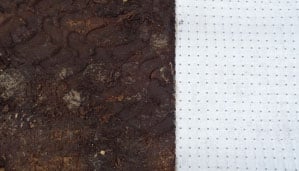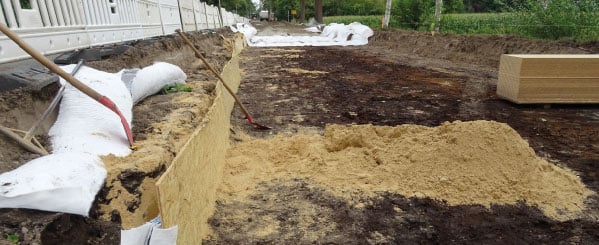Project: National roads L 133 in Grasberg, Germany
Products: Combigrid® 40/40 Q6 R 156 C | Secugrid® 30/30 Q6 | Secudrain® 201 WD 601 201
In Grasberg, Germany, asphalt concrete pavements in rural roads still exist. In the swampy area the state road L 133 was equipped with a stiff concrete pavement surface at the time.


Fig. 1: Installation of Combigrid® as base reinforcement in the Fig. 2: Detail- Combigrid® on subsoil with low bearing capacity construction area.
Challenge No°1
The high traffic load, the deteriorated road structure and the subsoil with its low beating capacity made rehabilitation unavoidable. Over time, cracks in the pavement had formed due to sattlements and speed limits had to be imposed.
Solution
The responsible state authority decide to use geogrids to archive a stiffening of the newly road structure. A complete soil replacement as an alternatice would have been too expensive due to the low bearing capacity of the subsoil. It would also have been challenging to implement for lack of space. With Combogrid® and Secugrid® geogrids, a technical solution was found to meet the described challenges.
 Fig. 3: Securing the natural gas pipeline in the lateral area.
Fig. 3: Securing the natural gas pipeline in the lateral area.
Challenge No°2
During the construction work, the client and the contractor were faced with another challenge. A gas pipeline running parallel to the roadway was much too close to the construction area. Relocating the pipeline would have gone far beyond the time frame available for the project.
Solution
Naue engineers, in cooperation with the responsible state authority, developed a concept within a short time to keep the lateral pressure resulting from the road pavement away from the gas pipeline.
The initially planned polypropylene (PP) geogrids were replaced by stiffer and less creep sensitive polyester (PET) geogrids and finally installed using the wrap-around method. As an additional safety buffer, the Secudrain® drainage mat was vertically placed next to the gas pipeline in a double layer arrangement.
Combogrid® was used at the base of the road structure as reinforcement with additional separation function between the sub-base and the soft peaty subsoil. The Secugrid® geogrid supplemented the reinforcement in the further construction to archive an optimal and sustainable stiffening effect for the complete road structure. The Secudrain drainage element formed a flexible frame due to the double laying to keep the lateral earth pressure away from the newly constructed road structure.
The use of Combogrid® and Secugrid® geogrids makes it possible to reduce future maintenance costs for the road pavement despite the soft subgrade and increasing traffic volumes.
Combogrid® and Secugrid® were successfully used to build sustainably, safetly, and economically for the future.

